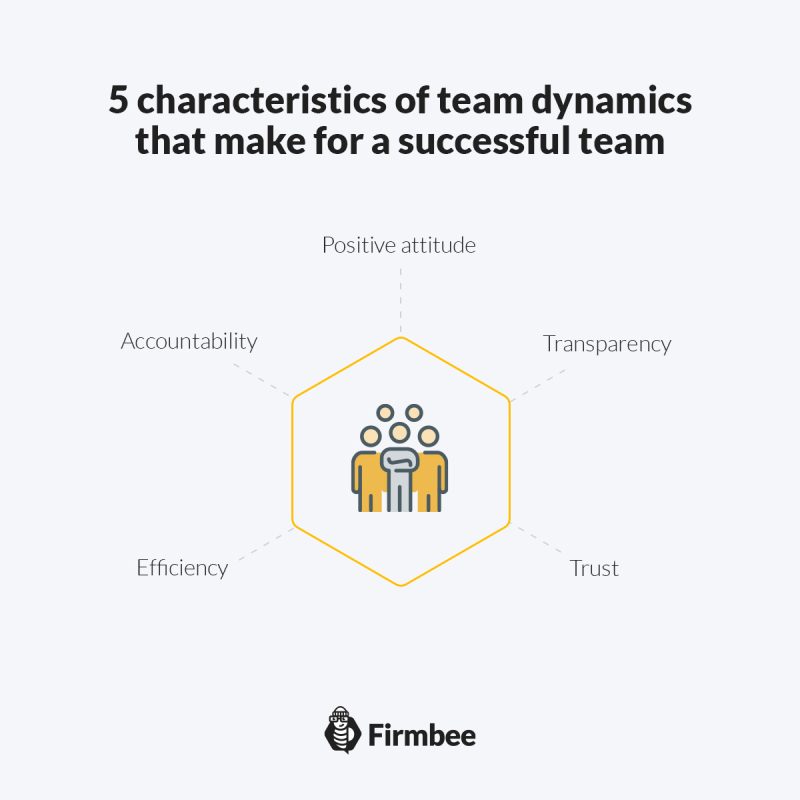What is team dynamics? Team dynamics reflects the organizational culture and work environment in which the team operates. Positive or weak dynamics is influenced by many factors, both determined by the organization and the employees themselves. Employees’ personalities, the way they interact, and the relationships between team members are the key issue here. Building positive relationships based on mutual respect will determine the team’s ability to succeed and thus increase productivity. Read on.
What is team dynamics? – table of contents:
- What is team dynamics?
- 5 characteristics of team dynamics
- How to improve team dynamics?
- Summary
- Check out how to build high-performing teams with Firmbee
What is team dynamics?
You can define team dynamics as a compilation of social relationships, psychological processes, phenomena, and events taking place in the work environment. The term team dynamics was first used by German-American psychologist, Kurt Lewin. Lewin assumed that the whole dominates the parts. This means that the group can’t be perceived as the sum of individuals, because the functioning of the group, as a whole, affects the individual behavior of its members. The key issue here is belonging to the group and the interdependence of employees.
Group dynamics connects various processes, starting from management and leadership, through interpersonal conflicts, to the identification of a position in the group. Most socio-psychological phenomena are shaped by group integration or differentiation.
The main factors that determine the productivity of a team are: satisfaction of one’s own needs, positive relationships, participation in the group, integration, friendly atmosphere, group prestige, the rivalry between competing teams, and effective internal and external cooperation. On the other hand, factors that undermine team dynamics are mainly: aggressive behavior, disrupted communication, the leader’s incompetence, lack of a clear goal, scarcity of human resources, poor motivation, instability, and insecurity.

5 characteristics of team dynamics
Effective and positive team dynamics to increase efficiency and productivity is only possible if a team is formed on the basis of the following values:
- Trust. To build trust in a group, all team members must know the organization’s goals, identify with them, know the value of their work, and have a sense of security about remuneration, motivation, and job stability. In an atmosphere of mutual trust, employees are bound to work more efficiently and creatively.
- Accountability. Employees should be responsible for their work. They ought to be rewarded for good results. If there are any errors or shortcomings, it’s a good idea to talk to them first, diagnose the problem, and take corrective action.
- Transparency. Without proper communication the team can’t be efficient. All messages, opinions, and ideas should be communicated clearly. Members of the group don’t have to agree with each other on everything, but they must make this clear directly to avoid unnecessary misunderstandings.
- Efficiency. It doesn’t matter how much time employees work together, but how they work, and what results they achieve. Therefore, it’s necessary to take care of the way you use your working time so that all tasks can be completed on time.
- Positive attitude. If one project doesn’t work out, don’t get demotivated, but learn from the committed mistakes, and carry out tasks with greater enthusiasm. Nothing is as destructive to morale as mutually contagious pessimism.

How to improve team dynamics?
To improve team dynamics, create the right culture and organizational atmosphere based on cooperation. A basic recommendation is to develop guidelines and a communication plan. Also, information channels (emails, phone), and preferred meeting days and times should be defined.
Employees, to work well together, must be open to the exchange of information and ideas to fully engage in their work. Only open discussion and communication can be the key to success.
Promoting teamwork is also an important recommendation. In fact, a team can achieve more than a single employee. Brainstorming meetings might be helpful in that regard. The work of the team should be supervised by a leader who should create space for innovation and cooperation. A good leader ought to recognize the team for a job well done. This always has a positive effect on morale and the atmosphere in the group.
It is also important to set goals together. The manager or leader should set the main goal, and the members of the group the way to achieve it. It is also useful to integrate the team outside work. Developing relationships based on friendship guarantees building a strong team, which results in increased productivity.
What is team dynamics – summary
It is difficult to imagine achieving both individual and organizational success without constructive cooperation among team members. Collaboration is a determinant of efficiency, effectiveness, innovation, productivity, and satisfaction with a job well done by the team. Good team dynamics enables group members to share skills, talents, and ideas on their way to achieving maximum efficiency.
You’ve just read the article: What is team dynamics? Read also: What is experiential learning?
Check out how to build high-performing teams with Firmbee:
If you like our content, join our busy bees community on Facebook, Twitter, LinkedIn, Instagram, YouTube, Pinterest.
Author: Nicole Mankin
HR manager with an excellent ability to build a positive atmosphere and create a valuable environment for employees. She loves to see the potential of talented people and mobilize them to develop.


















